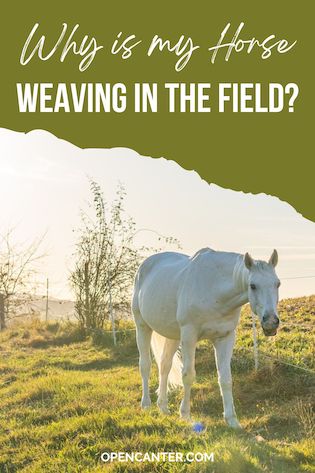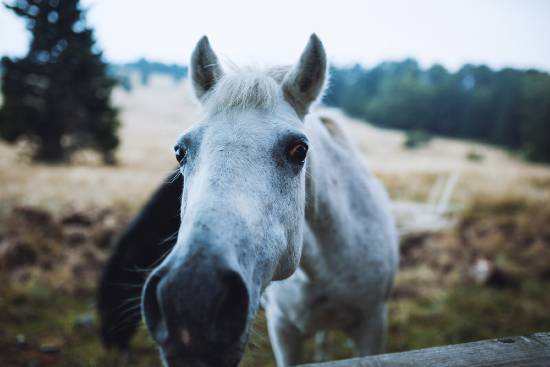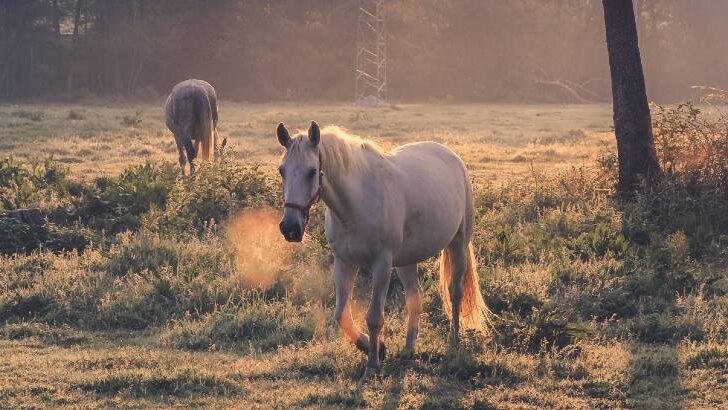Affiliate Disclaimer
As an Amazon Associate I earn from qualifying purchases. It helps me keep the website going. Thank you for your support.
Weaving is a common vice that many horses have. It is usually developed due to boredom, isolation, and stress. It is a repetitive rocking and swaying behavior traditionally done inside a stall. However, sometimes weaving can occur while a horse is out in the field. Why is my horse weaving in the field?
Horses can weave anywhere, including while they are out in the field. This is because weaving is a physical response to stress. If something is not right in a horse’s environment, they will weave to cope. When out in the field, horses will weave along any fence line.
As with other stable vices like cribbing or windsucking, it’s important to know about weaving so you can help your horse if they start. So, keep reading to learn more about why weaving happens in the field and what you can do to prevent it.

Why Do Horses Weave In The Field?
Similarly to in the stall, horses start weaving in the field because something there is causing them stress. This stressor could be the presence or lack of a herd mate in the pasture, insufficient food, and water, or something else. Horses may also weave to entertain themselves when boredom.
If a horse already weaves in the stall, it will be more likely to continue those behaviors when out in the field. It is compulsive and repetitive behavior. They do not copy the behavior from other horses. Horses never weave without a reason. They will also be predisposed to weaving if their parents do or did it as well (source). Another cause is anxiety due to a change in routine,
Many times weaving can be deterred by moving a horse from stall to field. However, if they continue doing it in the field, confinement in the stall was not the reason for it.
Other causes of weaving include:
- Not having enough room to move in the pasture
- Anticipation of food turnout
- Lack of socialization
- Lack of exercise
- Not getting enough forage in the diet
- Pain
- Stable management changes
- Past experiences or trauma
Whatever the reason for weaving, it has some serious effects if left untreated. Let’s go over them in the next section.
What Are the Effects of a Horse Weaving in the Field?
Because weaving involves repetitive swaying and rocking from one side to the other, joint and tendon problems are the most common effect. Weaving can also cause uneven hoof wear which leads to lameness.
When a horse goes lame, they have an uneven gait due to strain on muscles, ligaments, or tendons. The strain causes them pain which induces limping. When a horse is lame, it cannot compete or participate in hard exercise. If lameness is not managed, it can lead to more serious injuries.
Horses that are lame are put on stall rest with hand walking on supervised turnout. These activities can exacerbate weaving behavior due to confinement.
If a horse rhythmically swings their head and neck when weaving along with swaying their body, it can damage muscles and tendons in those areas as well.

Thankfully, weaving is not inherently lethal, dangerous, or contagious for horses. It can be controlled and lessened over time. Weaving is not a curable condition because a horse could resume the behavior at any time. However, there are several ways to treat weaving.
How Is Weaving Treated?
The most common ways to treat weaving include:
- Giving the horse a larger pasture space so they can explore and use their mind 1
- Providing the horse with herd mates they get along with to prevent isolation
- Make changes to their routine to make it more similar to life in a wild herd
- Hide food in toys and feeders to make them work for it and give them fewer opportunities to weave
- Spend time and play with your horse as much as possible
All of these treatments have a similar theme: keeping the horse mentally stimulated. The more the horse has their mind occupied, the less likely it will be to weave.
How Can Weaving Be Prevented?
Prevention methods for weaving whether in the stall or field are similar to treatment. Ensure the horse is getting enough roughage and minerals to eat. Pasture and stall them with horses they get along with. Exercise them regularly and vary their workout routine. Make spending time and bonding with your horse a priority.
All of these tactics help keep weaving at bay. The key to preventing weaving or any other vice is to monitor your horse’s behavior, see if anything is bothering them, and adjust their schedule accordingly. Make changes to their environment as needed to ward off stress and boredom.
Final Thoughts
Why is my horse weaving in the field? Horses weave in the field for the same reason they weave in the stall. Stress, boredom, a lack of socialization. Prevention and treatment of both stall and pasture weaving involves understanding what your horse is lacking and adjusting their space accordingly.




